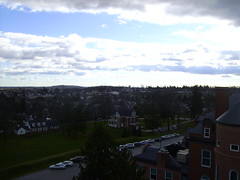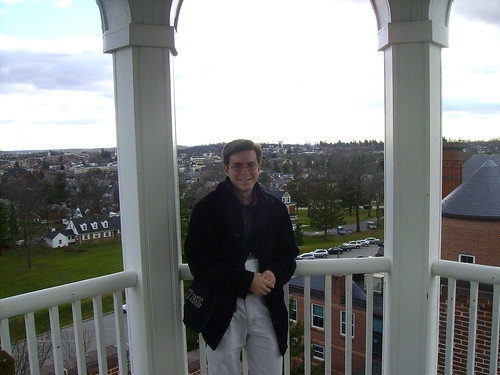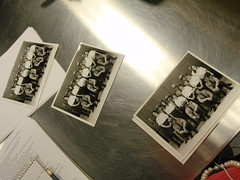 An internship at the Adams County Historical Society, located in historic Schmucker Hall on the Lutheran Theological Seminary Campus, was always the most attractive opportunity for me when considering a work experience in The Gettysburg Semester. The Society boasts a relatively new Battle of Gettysburg Research Room, which is a remarkable resource for any stage of research on the campaign. The staff at the Society is impeccably knowledgeable and helpful, particularly Director Wayne Motts and Collections Manager Benjamin Neely. These gentlemen and others on the staff and volunteer force were always willing to help in their own well-informed ways.
An internship at the Adams County Historical Society, located in historic Schmucker Hall on the Lutheran Theological Seminary Campus, was always the most attractive opportunity for me when considering a work experience in The Gettysburg Semester. The Society boasts a relatively new Battle of Gettysburg Research Room, which is a remarkable resource for any stage of research on the campaign. The staff at the Society is impeccably knowledgeable and helpful, particularly Director Wayne Motts and Collections Manager Benjamin Neely. These gentlemen and others on the staff and volunteer force were always willing to help in their own well-informed ways.At the Society, I learned many of the most important responsibilities of a public historian. My main interest during the internship lay with the Battle of Gettysburg and Union soldiers during the Civil War. My first project, therefore, was to scan and make searchable thousands of newspaper articles concerning the battle, the veterans, and the battlefield of Gettysburg from about 1880 to 1970. In doing this I learned countless fascinating details about the battle and enjoyed a staggering array of facts and anecdotes about the field of Gettysburg. One of the most engaging articles included a map from the men of the 1st Massachusetts Infantry, Brig. Gen. Joseph Carr’s brigade, detailing where every soldier in the regiment fell in the fields east of the Emmitsburg Road on July 2, 1863. This gave me a new appreciation for the battlefield which I might not otherwise have gained but through working at the Society. It was during this process of uploading newspaper articles that fellow Ohioan Wayne Motts took me on a fascinating tour of the George Spangler Farm, the Eleventh Corps field hospital where Brig. Gen. Lewis Armistead died.
My second project, which claimed the bulk of the semester, was to create finding aids for the numerous boxes of files pertaining to Corporal Skelly Post 9 of the Grand Army of the Republic in Gettysburg. Thus I became familiar with all the Union veterans who lived in Adams County through seeing their applications and names on the ledger books. Particularly rewarding was seeing the applications of two Medal of Honor recipients – John F. Chase of the 5th Maine Battery and Daniel P. Reigle of the 87th Pennsylvania Infantry. The most fascinating of all the G.A.R. records were the Post Historian’s Interviews, a collection of documents inquiring of local veterans about their experiences in the war; these included standard service information, but also more personal questions pertaining to the veterans’ most vivid memories and who their closest comrades were. These documents will be absolutely invaluable to anyone researching ancestors or local Civil War history.
 Schmucker Hall is a uniquely historic building in Gettysburg, operating during and after the battle as an observation post for both armies, a signal station, and one of the largest permanent hospitals in the area. Working in the meeting room on the first floor, I discovered halfway through the semester that the door I had been sitting near for so many weeks was actually the same one through which the battered men of the 151st Pennsylvania carried Lt. Col. George McFarland after that officer had been seriously wounded in the chaotic fighting in front of the Seminary on July 1, 1863. Perhaps the pinnacle of experiencing this history came on my last day at the Society when Ben Neely rewarded my diligent work with a rare ascent to the cupola to observe the town and the battlefield.
Schmucker Hall is a uniquely historic building in Gettysburg, operating during and after the battle as an observation post for both armies, a signal station, and one of the largest permanent hospitals in the area. Working in the meeting room on the first floor, I discovered halfway through the semester that the door I had been sitting near for so many weeks was actually the same one through which the battered men of the 151st Pennsylvania carried Lt. Col. George McFarland after that officer had been seriously wounded in the chaotic fighting in front of the Seminary on July 1, 1863. Perhaps the pinnacle of experiencing this history came on my last day at the Society when Ben Neely rewarded my diligent work with a rare ascent to the cupola to observe the town and the battlefield.The Adams County Historical Society provided me with the experience that should come with any internship during The Gettysburg Semester, but it also gave me many fond personal memories of my time spent in Gettysburg. From the fascinating newspaper clippings, to the personal stories in the G.A.R. records, to Thursday evenings in the Battle of Gettysburg Research Room with good semester friends and stellar research company, the internship was an experience of which I shall always be particularly proud.


